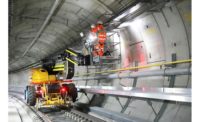DSJV runs two production lines to cast the eight segments needed for each of the contract's 13,700 lining rings at Chatham, which is 50 km away. "We are making one segment every seven minutes," says Gonzalez. Water transportation accounts for some 90% of segment deliveries to DSJV's tunnel portals and for spoil removal. Most of the total project's 6.5 million tonnes of spoil leaves London by boat or train, and 75% of it is being used to build a nature reserve up the coast.
DSJV's first TBM left the Limmo portal in late 2012 and broke into the huge cavern at Stepney Green last November. The trumpet-shaped cavern will contain the junction at which trains branch south to Woolwich and along the spur to Stratford. The 40-m-deep cavern is more than 100 m long and widenes to 17 m from nearly 14 m. It is linked to a twin cavern by a six-floor-deep shaft. Both were completed last August. The TBM is now headed for Whitechapel.
To limit movements beneath the buildings above, tunnelers must keep ground volume loss generally below 1% by using techniques such as controlling TBM face pressures. With fine controls, good instrumentation and real-time data, "we are seeing a third of the movement that was anticipated," says MacAdam.
Stations and Software
Stations are essentially concrete boxes built within slurry trench walls at either end of the 240-m-long platform tunnels, says Graham Williams, a station project manager with Arup Group Ltd. Arup, in a JV with WS Atkins plc, designed three stations. Platform tunnels at five stations were mined using SCL. At Bond Street and Tottenham Court Road, the running tunnels are being built first and widened with SCL, to form platform spaces.
As some 9,000 workers toil on Crossrail, CRL is storing all the digital data used in design and construction to help the future operator, a unit of Transport for London, maintain the assets. "We are building two Crossrails … the physical asset and a digital model," says Wolstenholme.
Since detailed work began in 2008, all the project's 25 main design firms have used the same 3D model systems, says Malcolm Taylor, CRL's head of technical information. CRL now owns and controls all electronic data generated by its designers and by nearly 100 constructing and logistics firms. That equals over a million electronic documents and even more CAD files.
Bentley Systems Inc., Exton, Pa., is providing all the software to Crossrail. Bentley also runs a Crossrail Information Academy at its central London office to train contractors in the use of building information modeling. Bentley worked with CRL to develop a new tool called Asset Painter to help manage the rail network's one million assets in a central data hub.
Design teams have handed their 3D and sometimes 4D model data to CLR, says Tony Bevan, an Atkins CAD manager, and CLR wants contractors to do the same. The response, however, has been mixed. "We are not using BIM yet," says Gonzalez, though his team is preparing a proposal.
"The industry is only in its infancy in understanding the value to be had in delivering the digital model," says Wolstenholme. "If that digital model is configured and organized in such a way that you can hand over the assets as a life-cycle model, then this has much more value to the end user."







Post a comment to this article
Report Abusive Comment